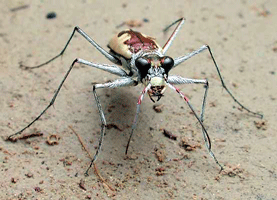mtDNA sequences can define insect species
 DNA-based species descriptions could enable a catalog of life on Earth. Without some sort of automated approach, I believe this goal is unattainable. Insects are a good place to start testing an automated sequence-based approach, as there are about 1 million insect species already described, and probably several million more to go. In upcoming August 2006 Systematic Biology Pons et al examine genus Rivacindela tiger beetles in Australia, providing an explicit test of a DNA sequence-based approach to defining species. They analyzed 468 individuals from 65 sites, using sequence data from 3 mitochondrial genes including DNA barcode region of COI, and found sequence variation was strongly partitioned between 46 or 47 putative species, using a novel tree-based, quantitative method of species recognition based on fixed unique diagnostic characters. Most (40 to 43) of the species entities were recovered by analyzing the three gene regions separately; COI alone produced the closest match to the full data set. The putative species defined by sequence data exhibited biological properties of species in terms of geographic ranges and known morphologic characters. Average divergence within species was .5%, much lower than average among species of 6.3% and between sister species of 2.2%. The sequence analysis took 3 days on a desktop computer, so if this approach proves useful, it can be a benchmark for testing faster methods.
DNA-based species descriptions could enable a catalog of life on Earth. Without some sort of automated approach, I believe this goal is unattainable. Insects are a good place to start testing an automated sequence-based approach, as there are about 1 million insect species already described, and probably several million more to go. In upcoming August 2006 Systematic Biology Pons et al examine genus Rivacindela tiger beetles in Australia, providing an explicit test of a DNA sequence-based approach to defining species. They analyzed 468 individuals from 65 sites, using sequence data from 3 mitochondrial genes including DNA barcode region of COI, and found sequence variation was strongly partitioned between 46 or 47 putative species, using a novel tree-based, quantitative method of species recognition based on fixed unique diagnostic characters. Most (40 to 43) of the species entities were recovered by analyzing the three gene regions separately; COI alone produced the closest match to the full data set. The putative species defined by sequence data exhibited biological properties of species in terms of geographic ranges and known morphologic characters. Average divergence within species was .5%, much lower than average among species of 6.3% and between sister species of 2.2%. The sequence analysis took 3 days on a desktop computer, so if this approach proves useful, it can be a benchmark for testing faster methods.
This entry was posted on Friday, June 30th, 2006 at 10:22 pm and is filed under General. You can follow any responses to this entry through the RSS 2.0 feed. Both comments and pings are currently closed.